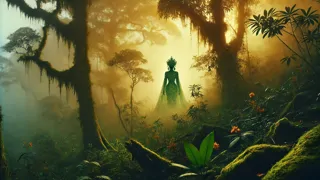Introduction
In the heart of Colombia's dense northern forests, where the Sierra Nevada de Santa Marta reaches toward the sky and the Andean foothills descend into misty valleys, an ancient guardian stirs as the wind begins to sing. Locals whisper her name with both reverence and fear: La Madremonte, Mother of the Forest. They say she was born from the first raindrops that fell upon sacred earth, a spirit woven from moss and vine, crowned with wildflowers. When intruders dare to fell a towering ceiba or burn vines for campfires, she gathers storms at dusk and unleashes her wrath in crackling thunder and torrential rain. Generations of indigenous Arhuaco and Kogi communities have honored her with offerings beneath moonlit palms, knowing that her protective fury preserves the balance between people and nature. Modern explorers find footprints pressed into softened soil, glimpses of a figure drifting through fog-laced clearings, or gusts of wind that form shapes reminiscent of a woman's silhouette. In modern times, as illegal logging and mining threaten her domain, rumors of storm spirals and missing trespassers have reignited her legend among conservationists. Step beyond the edge of cultivated fields, and you may hear her call—an echo of thunder that reminds you the wild has its own voice. This story plunges us into the emerald corridors of Colombia's most remote woodlands, tracing Madremonte's origins through ancestral rites, storm-swept nights, and the timeless bond between earth and sky.
Birth of the Storm Guardian
Long before Spanish chroniclers set quill to parchment, Arhuaco elders spoke of a living storm deep in the mountains. They told of a woman emerging from swirling winds, her form constructed of tangled roots and verdant leaves, hair woven from vines, eyes glinting emerald like dawn dew. Thunder was her heartbeat, each flash of lightning a ribbon of her restless spirit across sky-fallen canopies. When hunters took more than they needed or newcomers carved paths through sacred woods, the earth trembled under her power and storms gathered in her wake. Birds fell silent as raindrops began to drum on leaf litter, streams swelled to reshape riverbanks, and ceiba trees shivered under unseen breath. Shamans chronicled how her essence flowed through hummingbird wings and anaconda coils alike, binding every creature into one symphony of survival. These ancient tales, etched on stone and clay, portrayed Madremonte as a primal force responding to imbalance, a testament to the forest's fierce autonomy and enduring mystery. They believed that Madremonte's power waxed with the rainy season: when the paramo clouds descended and rivers swelled, her influence grew, strengthening roots and washing away sickness. Offerings of maize, coca leaves, and chicha were made beneath moonlit palms to placate her spirit and ask for rains to nourish crops, but only if respect for the forest was upheld. Beyond ritual, the forest thrummed with her unseen presence: vines curled to form arched corridors, orchids bloomed in improbable shadows, and mist danced like white banners around sacred clearings. To glimpse her silhouette in a clearing at twilight was said to ensure safe passage and fertile harvests; to displease her invited relentless deluges that could drown entire fields.

Trials Among the Trees
As settlers advanced into the lowland jungles in search of fertile ground, tractors and saws replaced the hunters' respectful axes, and Madremonte's temper flared with increasing severity. In the early twentieth century, news spread of entire swaths of mahogany and cedar trees reduced to stumps overnight. Plantations along the Magdalena River found their fields flooded after heavy storms, while dozens of workers reported unexplainable tremors beneath their feet. Farmers spoke of spectral figures drifting through tea palm groves long after sundown, and duplexes of lightning that formed the shape of a woman standing tall among broken palms. Logging companies dismissed these stories as superstition until a survey crew vanished without a trace, their campsites found abandoned and half-buried beneath piles of branches. Rumors of Madremonte's wrath sowed fear among crew members, forcing many to abandon their contracts rather than tempt the spirit's retribution. Environmental reports would later note accelerated regrowth in those very areas, as if the forest were urged to reclaim every scar left by axes and plows. One notorious incident occurred near the foothills of Tolima, where a rancher's cattle staked out under a newly cleared pasture suddenly stampeded toward the forest's edge as thunder snarled overhead. When the storm subsided, all but a handful of cattle were gone, and the land bore gouges that resembled footprints too large for any known beast. Ranch hands who ventured after the herd were turned back by sudden downpours and swirling gusts that knocked them to the ground. Left in their place, they discovered distinctive lianas woven into crude lariats, lying coiled like serpents at the forest's border. These men returned home with stories of a sentinel looming in the canopy, her eyes glowing like embers in the darkness, compelling them to respect the lines they had crossed.

In one village nestled on the banks of the Caqueta River, a young woman named Marisol defied local warnings to venture into the forest at twilight. She sought orchids for her mother's remedy, fearing the frailty of her ailing parent. As she knelt to gather blossoms beneath towering palms, the sky darkened suddenly, and the ground quaked beneath a gathering thunder. Blades of grass twisted into coils that barred her return path, and vines snaked silently across the forest floor. Sudden rains fell in drumming waves, and lightning framed the silhouette of a majestic woman standing atop a mossy boulder. Terrified, Marisol fell to her knees and cried for mercy. In that moment, the spirit approached, brushing back a tangle of hair like a living waterfall. Though her eyes sparked with the ferocity of a tempest, Madremonte offered Marisol the orchids untouched, urging her to heal but also warning her to protect every flower as sacred treasure. Marisol emerged with both relief and reverence, becoming a storyteller who passed this trial into legend. The villagers who witnessed the aftermath spoke of delicate orchid petals pressed into the soft earth as though placed by unseen hands, and footprints trailing from the pool where Marisol was sheltered. Her tale spread swiftly, cautioning harvesters to seek proper blessing and instilling humility in all who entered the green depths.
Moved by such encounters, a covert council of forest guardians formed in various hamlets. Led by elders versed in Arhuaco tradition, they pledged to patrol sacred grounds, plant seedlings in storm-wracked clearings, and record the ravages of illegal loggers. Don Luis, a retired ranger, fashioned talismans from braided palm fronds, inscribing them with symbols meant to curry favor with the spirit. Before sunrise, he placed these at the entrances to restricted groves, while his companion, Maria, conducted nightly vigils by lantern light, playing flutes whose lilting notes were said to beckon Madremonte's attention. Over time, they noticed that areas protected by these rituals experienced fewer intensifying storms and saw a faster recovery of wildlife populations. Word of this harmony spread, drawing researchers and documentary teams eager to chronicle the alliance between humans and spirit. They carried journals filled with sketches of rare orchids and tracks of ocelots, each entry marking a living map of Madremonte's shifting realm. When research drones flew overhead, they sometimes malfunctioned near forest edges, their cameras capturing only glimpses of shifting foliage and spectral silhouettes before currents forced them to retreat. In time, some academic papers began to reference the Madremonte Effect, a term describing how myth-inspired conservation could actually enhance biodiversity by fostering community stewardship.
In one fateful season of drought, a group of mercury-miners illegally dammed a tributary feeding a sacred wetland. They scoffed at warnings scrawled on palm boards and launched heavy machinery under the midday sun. That night, thunder crackled across a parched sky, and a violent storm tore through the camp, sending torrential rain spouting from riverbeds. Equipment was dislodged, campsites flooded, and several miners were carried away by swollen rapids. When survivors stumbled back to the nearest village, drenched and shaken, they swore they saw a towering silhouette drift over the churning waters, beckoning with one hand as if reclaiming the stolen flow. In the weeks that followed, the river's course realigned, creating pools that nurtured fish and amphibians once absent. The miners, chastened and fearful, dismantled their dams and joined locals in restoring the damaged banks, learning firsthand that defiance of Madremonte's will carried consequences that no lawsuit could contest. Journal entries from a regional ecological survey record how fish species once threatened by habitat loss rebounded in those new pools, a testament to the spirit's restorative wrath.
Today, Madremonte's trials resonate in law courts and academic halls far from the jungle. Environmental NGOs incorporate her legend into awareness campaigns, using evocative murals and animated short films to illustrate the precarious dynamic between growth and preservation. Teachers in riverside schools lead children on forest walks, pausing at ancient ceiba trees to recite chants believed to summon her watchful gaze. Hyperlocal radio broadcasts warn of deforestation risk and encourage farmers to adopt agroforestry, arguing that harmony with the land is the best way to earn her blessing. Meanwhile, seasonal storms still catch meteorologists by surprise, centering thunderheads above protected reserves while sparing adjacent cleared zones. These patterns fuel debate about the interplay of myth and meteorology, but for the people living within her reach, the message is clear: respecting Madremonte's domain ensures both safety and abundance. Through trials marked by wind and rain, the spirit continues to guide humanity toward a path where the forest thrives alongside human communities.
Echoes of Thunder
In the twenty-first century, adventurers tracking biodiversity hotspots have reported phenomena that defy meteorological logic. Backpackers trekking the foothills of Los Nevados National Park speak of sudden squalls emerging without warning, enveloping their campsites in sheets of rain, only to vanish as swiftly as they appeared. Photographers capture intricate patterns of lichen-splattered bark illuminated by lightning that seems choreographed, and ornithologists note how birdcalls fall silent before a low rumble, then resume as though in tribute. A French biologist examining amphibian populations recorded data loss on his laptop when an unexpected burst of static echoed through dense undergrowth, coinciding with a distant howl of wind. In all these accounts, the term Madremonte encounter passed quietly among seasoned field researchers. Their journals, filled with data tables and ecological assessments, often opened with a dedication to the spirit whose name acknowledges the delicate balance separating study from intrusion. Although digital instruments provide precise measures of humidity and barometric pressure, none can fully account for the abrupt shifts guided by some primal force that local guides still attribute to Madremonte's whim. Seminars at environmental conferences have featured maps of these anomalies, overlaying storm tracks with zones of intact forest cover, sparking discussion about whether the spirit's legend might correlate with ecological resilience.

Recognizing the power of narrative, regional governments in Antioquia and Choco have begun to enshrine Madremonte's principle of reciprocity into forest management regulations. New legislation, informally dubbed the Madremonte Clause, mandates community-led conservation districts where locals collaboratively monitor wildlife corridors and sustainable harvest zones. Under these guidelines, permits for resource extraction require ceremonial offerings and the accompaniment of a certified spiritual steward versed in indigenous protocols. Failure to comply invites fines and mandatory reparation through reforestation projects. Local council meetings often open with stories honoring Madremonte's wrath and mercy, reinforcing the idea that legal frameworks without cultural respect are incomplete. Educators and legal scholars praise this model as a pioneering fusion of customary lore and modern policy, arguing that inviting a guardian spirit into statutes strengthens both compliance rates and ecological outcomes. As rivers run clearer and wildlife corridors reconnect, the legend of the storm spirit becomes more than myth—it transforms into living legislation safeguarding Colombia's natural heritage. Conservation NGOs from abroad have partnered with community leaders to facilitate workshops on traditional chants and rainmaking dances, ensuring that Madremonte's voice continues to resonate in digital and spoken forms alike.
Even so, Madremonte's messages remain capricious at times. Rare but dramatic storm events occasionally strike zones of unexpected calm, uprooting invasive plantations and recharging parched wetlands. In 2019, drought-stricken coffee growers in Tolima experienced a sudden cloudburst so intense that it delivered more rain in an hour than their region typically received in a week. While meteorologists identified a converging front, local farmers credited the looming figure seen atop a ridgeline, arms raised as though summoning relief. They rebuilt terraces with stone retaining walls and replanted native shade trees, integrating both modern agronomy and ancestral blessing rituals. Farm cooperatives now celebrate an annual Rain for the Jungle festival, honoring Madremonte with parades and storm-chasing treks. Tourists flock to witness these ceremonies, blending academic studies of climate resilience with immersive cultural experiences. Here, thunder and dance merge, reminding attendees that nature's cycles are rhythms to be respected and revered. By sharing these tales via social media and travel blogs, artists and eco-influencers keep the spirit's warnings alive, helping communities adapt more quickly to changing weather patterns. This fusion of ancient myth and contemporary storytelling underscores how intangible heritage can inform tangible environmental strategies.
Guided by the legend, EcoMadre Expeditions offers responsibly curated treks through borderlands once considered too treacherous, framing each trail as a pilgrimage to Madremonte's sacred domains. Visitors learn permaculture techniques under the tutelage of local farmers and hear songs of the forest sung by Kogi choir members at dusk. Campsites are built on raised platforms away from natural waterways, ensuring streams remain unobstructed for amphibian migrations, and meals rely exclusively on foraged fruits and sustainably harvested cacao. As muffled thunder carries through the trees, expedition leaders invite guests to pause in silence, listening for the heartbeat of the forest. At night, lanterns reveal ghostly figures in raindrops, and fireflies flit in choreographed patterns that locals liken to Madremonte's gentle smile. By weaving myth into each itinerary, EcoMadre Expeditions demonstrates that respectful tourism can celebrate folklore without commodifying it, binding economic opportunity to stewardship of the living landscape. Feedback from participants often mentions a palpable empathy for the forest, and many extend their stays to join reforestation drives or apprentice with traditional weavers who craft offerings from palm fibers.
As twilight settles over Colombia's vast green tapestry, the echoes of thunder carry faint lullabies sung by a guardian spirit whose story is far from over. Scientists track shifting weather patterns caused by climate change and marvel at how zones influenced by Madremonte's storms maintain higher humidity levels and richer biodiversity. Schoolchildren compose new verses for her legend, adapting it to a world facing global warming and habitat loss. Environmentalists see in her legend an archetype for planetary stewardship—a reminder that every ecosystem, like every myth, demands respect and vigilance. Whether Madremonte is a metaphoric embodiment of the forest's resilience or a real spirit animating each gust and downpour, her presence unites communities across generations. In her storms, we find both warning and hope, for a world that listens to the voices of nature can endure far beyond the darkest clouds. May this story inspire all who hear it to honor the bonds between humanity and the wild, standing as vigilant stewards for countless generations to come. Communities, scientists, and travelers alike keep vigil for signs that guide our actions—a flashing branch, a sudden gust, a distant rumble—each serving as an invitation to walk alongside Madremonte in fostering a future where storms heal rather than harm.
Conclusion
As the green corridors of Colombia hum with life under canopies older than memory, the Legend of the Madremonte stands as a timeless reminder that nature is neither passive nor predictable. Through centuries, this storm-wielding guardian has taught humankind that every fallen branch, every drop of rain, and every shadow cast by lightning matters in the grand tapestry of the wild. Her presence—felt in sudden squalls, whispered in village chants, and revered in ceremonial offerings—bridges the ancient world of indigenous wisdom with modern efforts in conservation and sustainable development. Today, when maps are overlaid with biodiversity hotspots and environmental impact assessments, Madremonte's story emerges as both cultural heritage and living science, guiding laws, educational programs, and eco-friendly ventures. May this tale inspire us to approach the earth with humility and reciprocity, to honor the unseen forces that shape our world, and to remember that in every echo of thunder, the spirit of the forest still watches, urging us toward balance and renewal. Let each decision we make—from planting a sapling to crafting our cities—be guided by the symphony of storms and leaves that Madremonte plays across Colombia's living cathedral.

















